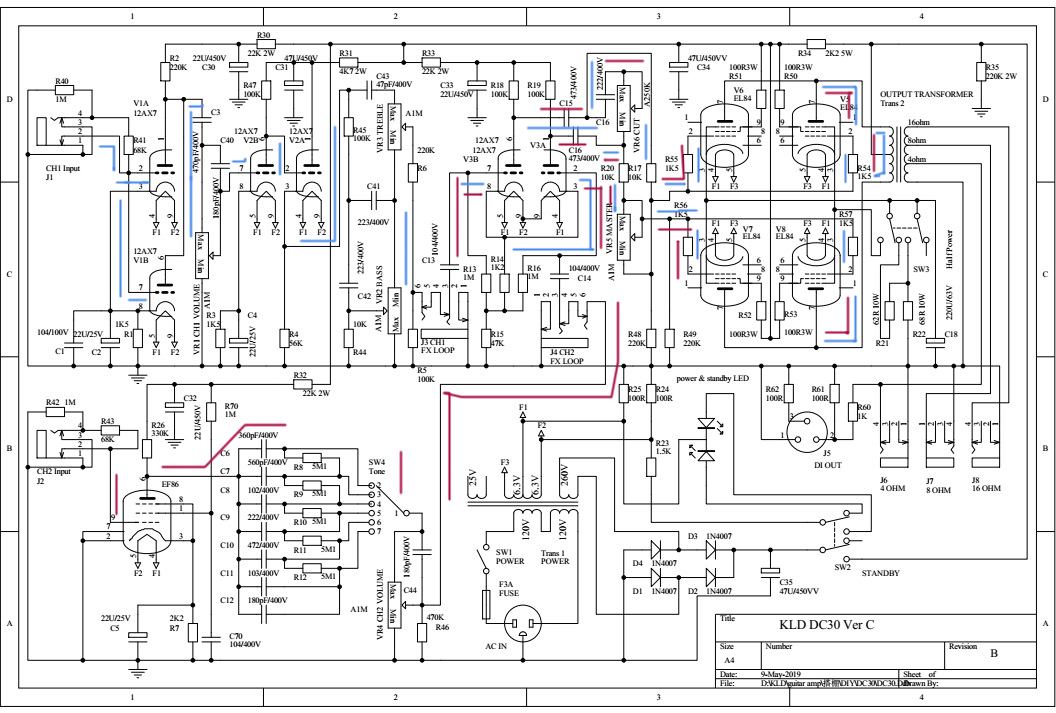What are features of KLD DC30 hand wired tube guitar amp
The KLD DC30 is based on Matchless DC-30, which is one of the most respected boutique tube guitar amplifiers ever made , known for its chime, touch sensitivity, dynamic clean-to-crunch transition, and complex harmonic texture. 
The output power of DC30 is 30 watts RMS. Th power tube amps of DC30 is four EL 84, which the output stage is a cathode-biased push-pull configuration, not pure Class A, The amp runs the tubes hot, with a shared cathode resistor and no fixed bias, giving it some Class A like characteristics (smooth clipping, strong even-order harmonics, and touch-sensitive feel)
The preamp tubes are three 12AX7 and one pentode EF86,Which constructs two independent channels: Channel 2: EF86, Channel 1: 12AX7 Top Boost type.
Speaker Configuration: Commonly 2X12inch (Celestion Greenback + G12H mix).
The channel is based around an EF86 pentode (instead of a 12AX7 triode), which provides higher gain and richer harmonic content. VR4 controls the Channel 2 volume independently.
This channel features a 6-position rotary tone selector (instead of a standard tone control pot). Each position switches between different capacitor values to create preset tone responses, ranging from darker to brighter.
The tone of this channel is known for its thick, midrange-rich character and early natural overdrive, highly sensitive to touch and guitar volume - perfect for dynamic playing.
Circuit traits:
- High plate voltage on EF86 (~250V range).
- Cathode biased (2k2).
- Uses tone selector network on the anode load path.
- Signal passes to phase inverter through a coupling cap and shared mixer resistor.

Channel 1 of DC30 is derived from Vox AC30 Top Boost circuit but modified for more headroom and Matchless voicing.
There is one dual-triode 12AX7 V2 used for two gain stages before tone stack. The tone stack of DC30 only has two controls : Treble VR3 and Bass VR2, which compensate for guitar pickups with a strong low-mid emphasis and limited high-frequency response resulting in a muddy, muffled sound.
The CUT control in Channel 1 is formed by the potentiometer VR6 and capacitor C16, which are connected between the two phase inverter output signals (the grids of the power tubes). This network creates a variable low-pass filter across the phase inverter outputs similar to the design used in other VOX-style amplifiers. It shapes the high-frequency response of the amp and operates after the phase inverter, just before the power tubes. When you turn the CUT knob one way, more high frequencies are shunted to ground, effectively reducing treble before it reaches the power stage. Turning it the other way allows more highs to pass, making the amp sound brighter and more biting. This control is different from the typical treble control found in preamp tone stacks
The tone of DC30 is bright, chimey cleans and smooth compression when pushed, compared with vintage VOX AC30 .
Circuit traits:
- "Top Boost" network (220k mixing resistors, A1M volume pot VR1, 100pF bright cap)
- Cathode bias typically 1.5k R1with bypass capacitor C2(~22uF).
- Shared or paralleled tone stack (treble/bass like VOX).
The Long-tailed pair phase inverter of DG 30 is similar to Fender and Marshall topology. You can watch circuit of our Bassman 25 and JCM 25
The power tube amp of DC30 is special . Four EL84 output tubes running in Class A cathode bias, shared resistor (62-68ohm R21, R22, SW3 is switch selecting Pentoide/Tritoid), which produces distinctive Matchless "compressed clarity" with strong upper-mid harmonics.
- Channel 2 (EF86): thick, raw, gritty, more midrange drive.
- Channel 1 (12AX7):brighter, jangly, cleaner, with tight low end.
- Can jumper channels for blended tones (common mod).
- Excellent touch dynamics- cleans up beautifully with guitar volume roll-off.
- Characterized by:
- Glassy highs
- Articulate mids
- Smooth compression
- Tight, focused bass